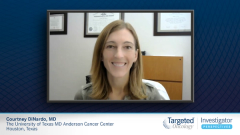
Dose Management for Venetoclax plus Azacitidine
Dr Courtney DiNardo details the dosing recommendations for venetoclax plus azacitidine and the importance of bone marrow assessments.
Courtney DiNardo, MD: The recommendation and the approved dosing of the combination is standard azacytidine or standard decitabine. Azacytidine is 7 days, 75 mg/m2 days 1 to 7 either IV [intravenously] or subcutaneously with venetoclax, with a goal dose of venetoclax 400 mg. There’s a daily dose ramp up. You go from 100 to 200 to 400 mg of venetoclax for the first 3 days, and you make sure during those first 3 days that your patient hasn’t had any evidence of tumor lysis. You’re checking labs daily. The venetoclax is, in theory, continuous for 28 days. Many patients have cytopenias and therapy-related myelosuppression from this combination. Very few patients in my clinic get continuous 28-day venetoclax cycles. That’s the recommendation, and we’ll talk about how I dose adjust and attenuate the venetoclax in the next few segments.
I said the dose was 400 mg of venetoclax. That’s true, but there are a lot of drug-drug interactions with venetoclax because it’s a CYP3A inhibitor. If you’re using another CYP3A inhibitor, like voriconazole or posaconazole—1 of the azoles—you absolutely need to modify the venetoclax dose. There are recommended guidelines so that you end up getting an equivalent venetoclax concentration. If you’re using venetoclax 400 mg with an azole, the venetoclax concentration is going to be much too high because of those CYP interactions.
When you’re using a venetoclax-azacytidine regimen, the most important thing is to do a bone marrow [evaluation] at the end of the first cycle. It doesn’t have to be exactly on day 28. It can be day 21, 24, 28—sometime during that last week—because the majority of patients are going to respond, and they’re going to respond within the first cycle. It’s really important to know if patients’ counts are low. If it’s because they’re in a remission, they’ve already cleared their leukemia out of their bone marrow. If they still have persistent leukemia, then you can go straight into the second cycle. You can continue the venetoclax, and you can start the second cycle on day 29 of that patient’s treatment plan. But most of the time, that end-of-cycle bone marrow is going to be clear. There are not going to be blasts there, and the counts are still going to be low. In that case, you hold therapy for a week or 2, for a full-count recovery to happen. That patient is in a remission, so their counts are low not because of leukemia but because of the combination therapy you’ve given them. So you hold therapy, you wait a week or 2, the counts recover, and then you start the next cycle. When you start the next cycle, if you have to hold therapy for a week or 2—which the majority of the time you’re doing—I’ll typically transition them to 21 days of venetoclax per cycle, so they get that break at the end of the cycle to allow those counts to recover and stay on schedule.
The reason the bone marrow assessment at the end of cycle 1 is so important is because almost all the patients that you’ll see at the end of the first cycle on azacytidine and venetoclax will still be cytopenic. Their white blood cell count is still going to be neutropenic. They’re still going to be anemic. They may still be requiring blood and platelet transfusions. If that’s because of leukemia, that’s fine. We know how to give ongoing hypomethylating agent cycles. We’ve done that for decades in patients with MDS [myelodysplastic syndrome] and AML [acute myeloid leukemia], and it typically takes 4 to 6 cycles to respond. We keep the treatment going on a 4-week cycle because it can take that long for responses to happen.
But in the majority of patients getting these venetoclax combinations, you see very early responses. The average response time is 1 cycle. If those counts are still low, if they’re still neutropenic and requiring transfusions not because of the leukemia but because their bone marrow is still ablated from the venetoclax combination, then you don’t want to start another cycle. You don’t want to compound toxicity that they haven’t recovered from, so you need to do that bone marrow to figure out why your patients’ counts are still low. If they’re still low because the leukemia is clear, then this therapy has worked well. You need to wait a week or 2 for counts to recover before you start the next cycle to improve the tolerability of this therapy for your patient.
Transcript edited for clarity.









































